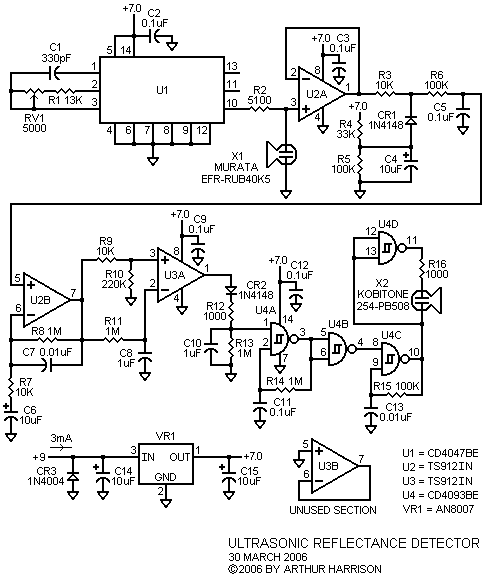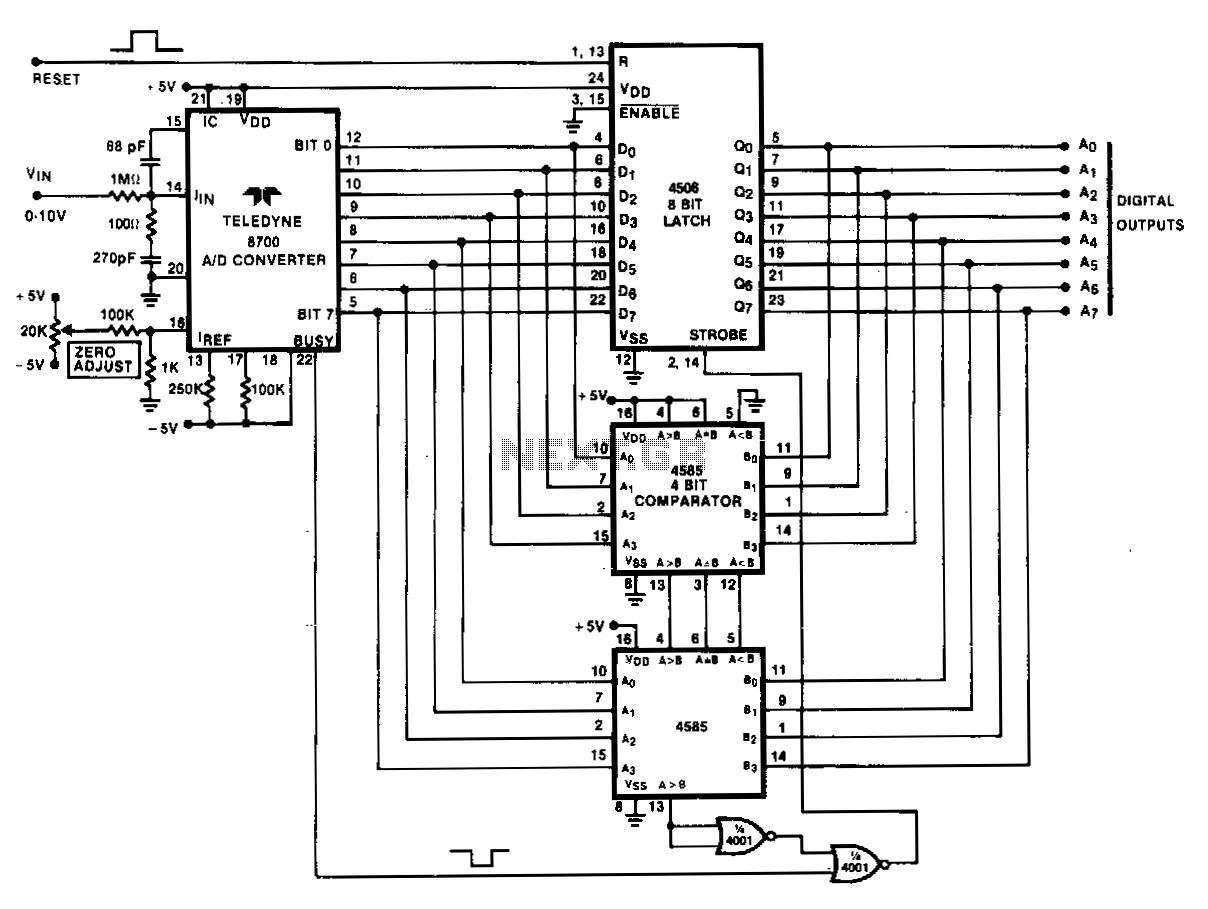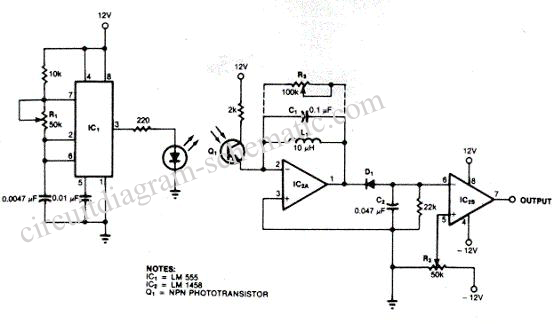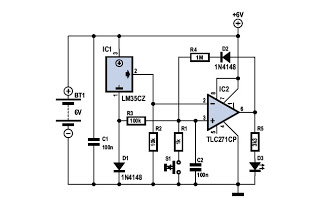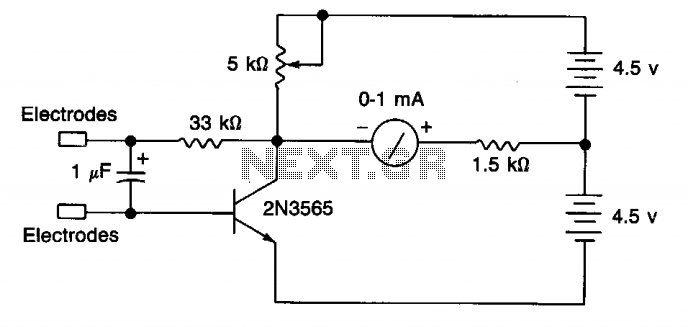
Metal Detector with CS209A
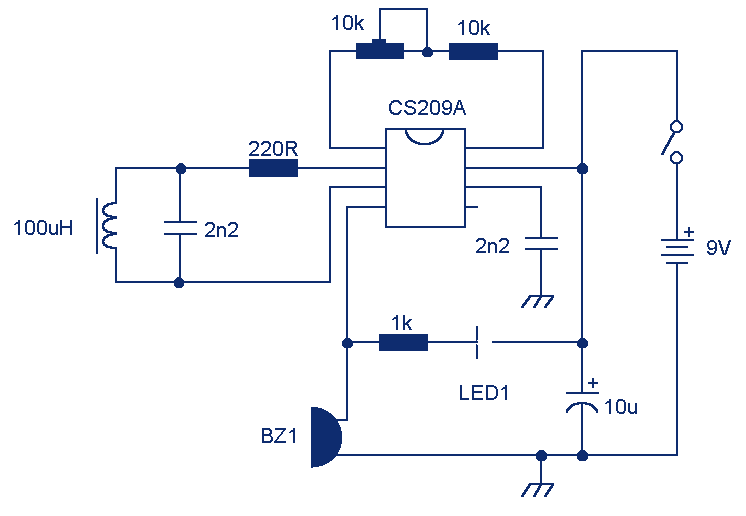
A single chip metal detector with a range of a few inches. This is useful for detecting nails or screws in walls and floors, or for locating buried mains cable. The heart of the circuit is a single IC, the CS209A made by Cherry Semiconductor. The detector is a single 100uH choke. The IC has an integral oscillator; the choke forms part of an external LC circuit, its inductance being altered by the proximity of metal objects. It is the change in oscillation that is amplified and demodulated. LED 1 will light and the buzzer will sound when the choke changes inductance. Setup is easy; VR1 is adjusted with the choke away from any metal source so that the LED lights and the buzzer sounds. The control is backed off so that the LED goes out and the buzzer stops. Now, when the choke comes into contact with any metal object that alters its inductance, LED 1 and the buzzer will activate.
The circuit operates using the CS209A integrated circuit, which functions as the primary control unit. The IC's internal oscillator generates a frequency that is dependent on the inductance of the external choke. The choke, rated at 100 microhenries, is critical as it forms part of the LC circuit along with the capacitor connected to the IC. The inductance of the choke is sensitive to nearby metallic objects, which causes a change in the oscillation frequency.
When the circuit is powered, the oscillator operates at a baseline frequency. If a metal object approaches the choke, the inductance increases, leading to a shift in the oscillation frequency. This change is detected by the CS209A, which amplifies the signal and demodulates it to trigger the output components. The output is connected to an LED and a buzzer, which serve as indicators of metal detection. When the choke detects a metallic object, the output goes high, activating LED 1 and sounding the buzzer, providing immediate feedback to the user.
The setup process involves adjusting the variable resistor (VR1) to establish a baseline condition where the choke is not influenced by metal. This ensures that the LED remains off and the buzzer silent until a metal object is detected. Once the baseline is set, any nearby metal will cause the LED to illuminate and the buzzer to sound, confirming the presence of metal.
For users seeking to build or repair this circuit, it is important to note that the CS209A is no longer available from Maplin, but an equivalent part, the CS209AYN, can be sourced from ON Semiconductor. The specific package required for this application is the 8-pin DIN type, denoted as CS209AYN8. Proper sourcing of components is essential for the successful assembly and functionality of the metal detector circuit.A single chip metal detecor with a range of a few inches. This is useful for decting nails or screws in walls and floors, or for locating buried mains cable. The heart of the circuit is a single IC the CS209A made by Cherry Semiconductor. The detector, is a single 100uH choke. The IC has an integral oscillatorm the choke forms part of an external LC circuit, its inductance being altered by the proximity of metal objects. It is the change in oscillation that is amplified and demodulated. Led 1 will light and the buzzer will sound when the choke change sinductance. Set up is easy, VR1 is adjusted with the cjoke away from any metal source so that the LED lights and buzzer sounds.
The control is backed off so that the LED goes out and buzzer stops. Now when the choke comes into contact with any metal object that alters its inductance, LED 1 and the buzzer will activate. Since I first wrote this article Maplin no longer sell the CS209A. However the same part CS209AYN may be bought from ON semiconductors, direct link below. Note that the package 626-05 is the 8 pin DIN type that is required. CS209AYN8 🔗 External reference
The circuit operates using the CS209A integrated circuit, which functions as the primary control unit. The IC's internal oscillator generates a frequency that is dependent on the inductance of the external choke. The choke, rated at 100 microhenries, is critical as it forms part of the LC circuit along with the capacitor connected to the IC. The inductance of the choke is sensitive to nearby metallic objects, which causes a change in the oscillation frequency.
When the circuit is powered, the oscillator operates at a baseline frequency. If a metal object approaches the choke, the inductance increases, leading to a shift in the oscillation frequency. This change is detected by the CS209A, which amplifies the signal and demodulates it to trigger the output components. The output is connected to an LED and a buzzer, which serve as indicators of metal detection. When the choke detects a metallic object, the output goes high, activating LED 1 and sounding the buzzer, providing immediate feedback to the user.
The setup process involves adjusting the variable resistor (VR1) to establish a baseline condition where the choke is not influenced by metal. This ensures that the LED remains off and the buzzer silent until a metal object is detected. Once the baseline is set, any nearby metal will cause the LED to illuminate and the buzzer to sound, confirming the presence of metal.
For users seeking to build or repair this circuit, it is important to note that the CS209A is no longer available from Maplin, but an equivalent part, the CS209AYN, can be sourced from ON Semiconductor. The specific package required for this application is the 8-pin DIN type, denoted as CS209AYN8. Proper sourcing of components is essential for the successful assembly and functionality of the metal detector circuit.A single chip metal detecor with a range of a few inches. This is useful for decting nails or screws in walls and floors, or for locating buried mains cable. The heart of the circuit is a single IC the CS209A made by Cherry Semiconductor. The detector, is a single 100uH choke. The IC has an integral oscillatorm the choke forms part of an external LC circuit, its inductance being altered by the proximity of metal objects. It is the change in oscillation that is amplified and demodulated. Led 1 will light and the buzzer will sound when the choke change sinductance. Set up is easy, VR1 is adjusted with the cjoke away from any metal source so that the LED lights and buzzer sounds.
The control is backed off so that the LED goes out and buzzer stops. Now when the choke comes into contact with any metal object that alters its inductance, LED 1 and the buzzer will activate. Since I first wrote this article Maplin no longer sell the CS209A. However the same part CS209AYN may be bought from ON semiconductors, direct link below. Note that the package 626-05 is the 8 pin DIN type that is required. CS209AYN8 🔗 External reference
